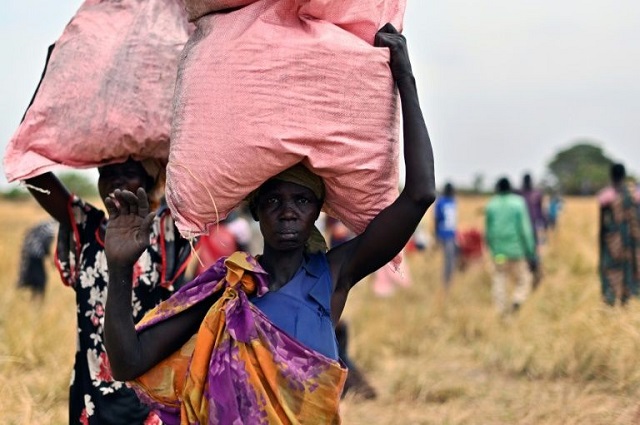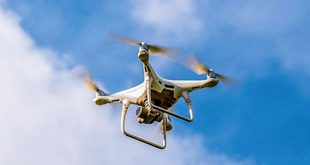
Mogok, South Sudan | AFP | The villagers hear the distant roar of jet engines before a cargo plane makes a deafening pass over Mogok, dropping sacks of grain from its hold to the marooned dust bowl below.
There is no other way to get food to this starving hamlet in South Sudan. There are no roads, and the snaking Nile is miles away.
After enduring famine-like deprivation, women sprint to gather the rations that must sustain their families for months.
“The children were eating leaves,” Nyawal Puot, 36 and a mother of five, told AFP in Mogok, a cluster of thatch huts on a barren plain, many days walk from anywhere in northeast South Sudan.
Mogok was saved from the brink, but one in two South Sudanese are starving, some approaching famine, just as President Salva Kiir and rebel leader Riek Machar have once again united in government to try and lead the country out of six years of war.
In February, just days before the old foes declared an end to the conflict their rivalry started, the United Nations announced hunger in South Sudan was again at crisis levels.
The situation is forecast to worsen by July, posing an early test for the leaders, who have a history of struggling to share power in peacetime, and a government which has never provided any services to its people.
– Last resort –
Those urging an emergency response say peace and stability offers South Sudan its best shot at averting a repeat of a 2017 famine.
But feeding millions is costly, difficult and dangerous in a country as inaccessible as South Sudan, where armed conflict persists, and food has been used as a weapon of war with the UN saying last month that civilians had been “deliberately starved”.
In Mogok, floods at the height of planting season in late 2019 turned fields into swamps, ruining crops meant to last half the year.
“People couldn’t grow anything. There was no way to get food,” Puot told AFP.
She would go foraging, sometimes for days at a time, but found little more than shrubs and wild fruit that made some children ill.
The deluge also washed away whatever dirt roads existed, cutting routes to the outside world. South Sudan has an estimated 250 kilometres (155 miles) of paved road in a country the size of France.
“South Sudan is one of the most isolated, rural, difficult-to-reach countries in the world. You can fly for hours without seeing a road,” Matthew Hollingworth, country director for the World Food Programme (WFP) told AFP.
South Sudan is the last place on earth where food is airdropped, and in Mogok there was little other choice: without the tonnes of grains and cereals, people would have simply perished.
But six million South Sudanese — roughly half the entire population — are struggling to feed themselves, according to the latest data on food insecurity.
Some 20,000 are just a step away from famine.
– Lean season –
Remarkably, this represents something of an improvement.
Last year, nearly seven million people were starving in the equivalent “lean season”, underscoring the connection between war and hunger.
A lull in fighting after September 2018, when South Sudan’s warring camps signed a ceasefire, allowing some farmers to return to their fields for the first time in years, and markets to flourish.
Cereal production rose 10 percent, WFP says, though the country still produces well below what it needs.
Airdrops are the costliest means of food delivery, about eight times more expensive than road freight.
But these too have fallen off steeply in peacetime.
Three years ago, WFP had eight cargo planes running airdrops “all day every day” to about 1.3 million people, Hollingworth said.
“Today, because the ceasefires have come into being, and the peace is holding, those numbers have shrunk” to three planes serving about 400,000 people.
– Breaking ground –
Better security has opened access to places written off as too remote or hostile, a breakthrough in a country considered the most dangerous in the world to be an aid worker.
Waterways through the Sudd, one of the world’s largest wetlands, have been mapped for the very first time, allowing food to be safely transported by river, and stored on barges ahead of the lean season.
For the first time, amphibious vehicles have reached villages hidden in the Nile tributaries, while trucks have carved roads into isolated bushland in the northeast.
“We couldn’t do that in previous years, because there was active fighting up there,” said Fiona Lithgow, who heads WFP’s specialist units brokering access in South Sudan.
Despite the fanfare in Juba, where enemies have shaken hands and declared peace, violence could still impede the Herculean task of feeding millions in coming months.
In central Equatoria, holdout rebels have refused to lay down arms, creating instability in the country’s lush breadbasket at a time when food is desperately needed.
An invasion of desert locusts, meanwhile, threatens what crops survived a terrible harvest season marked by record rainfall and floods.
But if stability prevails, the airdrop over Mogok could be the last, Hollingworth said, with a new road planned from the village to nearby towns and marketplaces to end its dependence on emergency rations.
“Peace will bring that change,” Hollingworth said.
 The Independent Uganda: You get the Truth we Pay the Price
The Independent Uganda: You get the Truth we Pay the Price


